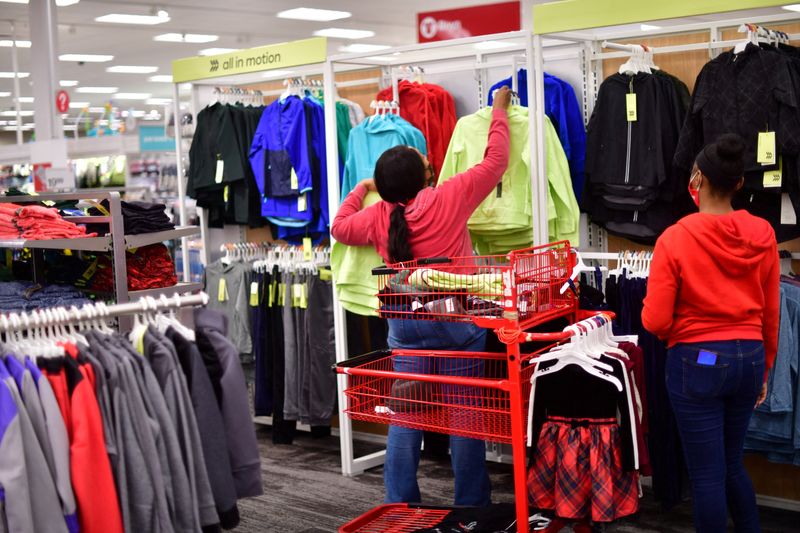
- Summary
- The consumer confidence index falls to 106.4 in May
- Labor market gauge softens; more say jobs hard to find
- Buying intentions for cars, homes, and major appliances ease
- House prices accelerate year-on-year in March
U.S. consumer confidence eased modestly in May as persistently high inflation and rising interest rates force Americans to become more cautious about buying big-ticket items, including motor vehicles and houses, which could curtail economic growth.
The survey from the Conference Board on Tuesday also showed consumers’ perceptions of the labor market softening a bit this month. Though the drop in confidence was small, it suggested that the Federal Reserve’s aggressive monetary policy actions to slow demand was starting to have an impact.
“We can never underestimate the U.S. consumer,” said Jennifer Lee, a senior economist at BMO Capital Markets in Toronto. “But plans to pull back on purchases, and become a little more cautious, is something that the Federal Reserve would welcome as it aims to cool demand.”
The Conference Board’s consumer confidence index slipped to a reading of 106.4 this month. Data for April was revised higher to show the index at 108.6 instead of the previously reported reading of 107.3. The index remains above its pandemic lows.
It has fared much better than the University of Michigan’s survey, where the consumer sentiment index is at an 11-year low. The Conference Board survey puts more emphasis on the labor market.
The survey’s so-called labor market differential, derived from data on respondents’ views on whether jobs are plentiful or hard to get, fell to 39.3 this month from a reading of 44.7 in April. That was the first time in a year that this measure, which correlates to the unemployment rate from the Labor Department, was below 40.
About 12.5% of consumers viewed jobs as “hard to get,” up from 10.1% in April. At face value, it suggests that the jobless probably ticked up from a two-year low of 3.6% in April.
Despite consumers’ somewhat unfavorable perceptions, the labor market is tightening, with the Conference Board noting that “they do expect labor market conditions to remain relatively strong, which should continue to support confidence in the short run.”
There were a record 11.5 million job openings on the last day of March and an all-time high of 4.5 million workers who resigned.
Stocks on Wall Street were lower. The dollar was steady against a basket of currencies. U.S. Treasury prices fell.
INFLATION PEAKED
Consumers’ inflation expectations over the next 12 months dipped to 7.4% from 7.5% in April. That fits in with economists’ views that inflation has likely peaked.
The Fed has increased its policy interest rate by 75 basis points since March. The U.S. central bank is expected to hike the overnight rate by half a percentage point at each of its next meetings in June and in July.
With prices still high and borrowing costs rising, consumers are reassessing their spending plans. The share of consumers planning to buy a motor vehicle over the next six months dipped. Fewer consumers intended to buy major household appliances like refrigerators, washing machines, dryers, and television sets.
But the buying plans remained at levels sufficient to keep consumer spending growing and the overall economy expanding. Rising interest rates and the accompanying tightening in financial conditions have left Americans worried about an imminent recession. Economists say the hand-wringing about an economic downturn was exaggerated, noting the record high job openings and resignations.
“Recessions are ultimately a loss of faith,” said Bernard Yaros, an economist at Moody’s Analytics in West Chester, Pennsylvania. “Yet consumers have no fear when it comes to job security. People are quitting their jobs at a prodigious rate, knowing they will easily find another job given the record number of open job positions.”
Consumers this month also showed less inclination to buy a house as rising mortgage rates and record house prices eroded affordability.
A separate report on Tuesday showed the S&P CoreLogic Case-Shiller 20 metropolitan area home price index surged a record 21.2% on a year-on-year basis in March after increasing 20.3% in February. Tight inventory, especially of previously owned houses, is driving house prices. Big price gains were recorded in a number of cities including Tampa, Phoenix, and Miami.
Strong house price inflation was reinforced by another report from the Federal Housing Finance Agency showing home prices increased 19% in the 12 months through March after rising 19.3% in February. Price gains were across the board, with notable increases in the South Atlantic, East South Central, West South Central, Mountain, and Pacific regions.
With demand slowing, house price inflation will cool down. Reports this month showed continued declines in sales of new and previously owned homes in April. Applications for loans to purchase a home have also been dropping.
“House price gains will be far more modest from here,” said Matthew Pointon, senior property economist at Capital Economics in New York. “We expect annual growth to slow to zero by mid-2023.”


